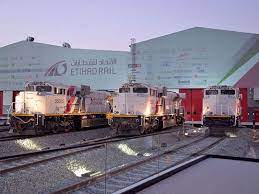The UAE economy is set to get a major boost as Etihad Rail comes onstream, a new report has said.
The rail network will boost the country’s freight transport sector, supporting ongoing growth in one of the key components of the local economy, according to Emirates NBD Research.
Trade and freight transport services have been historically important in the development of the UAE, and Dubai in particular, with the city having long been a key entrepot for regional trade flows. “This has been bolstered over recent decades with a series of major infrastructure projects that have further cemented this role and made Dubai a key global logistics centre,” Daniel Richards, Mena Economist at Emirates NBD Research, wrote in a report.
The improved freight transport mix provided by the railway will support the UAE’s ambitious industrial development plans over the coming decades, including Operation 300 billion, which aims to raise the industrial sector’s contribution to the economy from Dh133 billion to Dh300 billion by 2031. Phase one of the railway has already been used effectively by Abu Dhabi and contributed to the expansion of Adnoc’s operations at the Shah sour gas fields and the doubling of the emirate’s global market share for sulphur production, the report said. “An effective rail network, well connected to the country’s bulk cargo shipping facilities and coastal processing plants, will support ongoing growth in heavy industry. The intermodal connectivity can also support the planned development of domestic manufacturing,” Richards notes in the report.
Etihad Rail now links all seven emirates since its completion was announced on March 2. The initial phase of the project, which sees freight trains operating between the Shah gas field and the industrial area of Ruwais, was completed in 2016 and has already been transporting as much as 22,000 tonnes of sulphur a day for Adnoc. With the announcement this month, the line now runs for 900km from the UAE’s southern border with Saudi Arabia through to Fujairah and connects all of the major ports including Khalifa Port and Jebel Ali on the way. Not only will this boost rail freight volumes in the near term, but the eventual linkage with the rail networks of the rest of the GCC should support regional trade growth and economic integration.
The ongoing investment in the infrastructure sector should also help maintain the UAE’s attractiveness as a place in which to invest and do business. The UAE’s transport sector is already ranked eighth in the world on the Global Competitiveness Index even before the new rail network is added into the mix, and this will encourage greater private and foreign investment in the country. It also adds to the attractiveness of the existing warehousing facilities and transhipment ports like Jebel Ali. As the sector develops at a faster rate the nascent rail network will also help bolster the UAE’s position relative to its regional peers as regional competition in some areas intensifies – the UAE currently ranks higher on almost every transport metric ranked by the World Economic Forum as compared with its GCC neighbours.
The transport and storage sector accounts for around 4.5 per cent of the UAE’s GDP, down from a peak of 6.8 per cent in 2015. For Dubai, the sector is even more meaningful as it produced 9.2 per cent of GDP in 2021, although this was also down, from 11.6 per cent over 2014-2016. While the share of output has shrunk in recent years this is likely a product of the as-yet incomplete recovery of global air travel since the pandemic rather than anything related to the freight transport sector. Transport and storage GDP shrank by around 30 per cent in 2020 as global travel was paused but it has been steadily recovering since, and the freight component has likely underpinned this.
Looking ahead, the slowdown in global trade threatens growth this year after the remarkable resilience of the sector through the pandemic: DP World chairman and CEO Sultan Ahmed bin Sulayem cautioned in March that there were multiple challenges facing global trade flows in 2023. Nevertheless, the UAE’s investment in the freight transport network will put the country in a position of relative strength compared with its peers.
Looking further ahead, the eventual launch of passenger rail services on the network will support the planned population growth in the UAE – Dubai alone plans to grow its population from around 3.5mn currently to 5.8mn by 2040. Growth of this scale will likely mean that communities are developed further from the current business and social centres of the emirate, meaning that workers’ commutes will be longer than presently.
An effective passenger rail network, connected to an expanded public bus service at its various termini, will help shorten journeys for commuters and help alleviate congestion on the existing road network as the population grows. A widely utilised public transport system also offers the government an opportunity for revenue, helping the diversification efforts and the move away from a reliance on oil sales to drive government activity. Rail’s development will also help the UAE meet its ambitious net-zero targets over the coming decades by limiting the growth of trucks and passenger vehicles on the roads. The German government has estimated that rail freight produces six-times less carbon dioxide as compared with road freight, with similarly large savings set to be had through curbing the number of individual car journeys.
Khaleej Times



